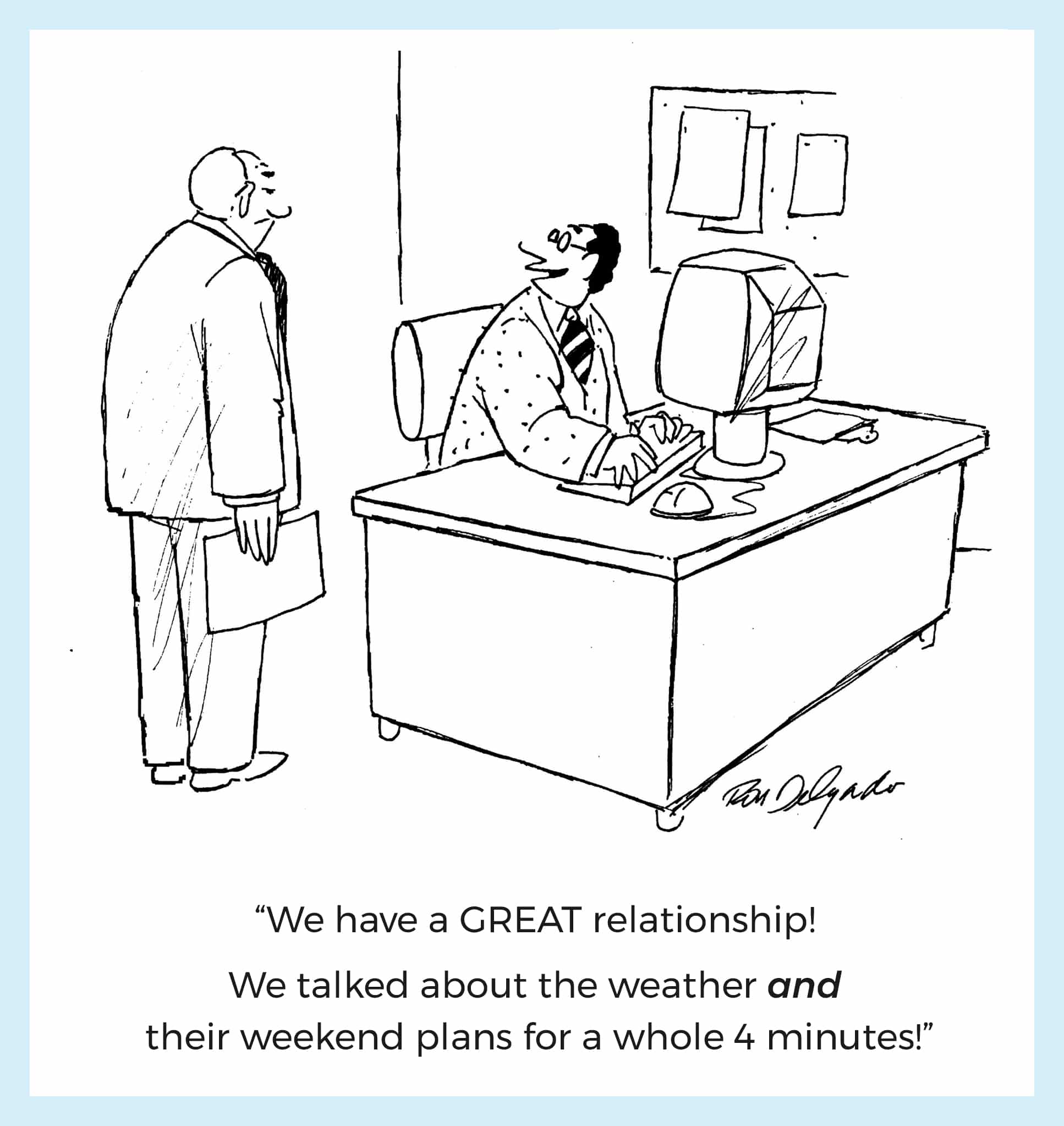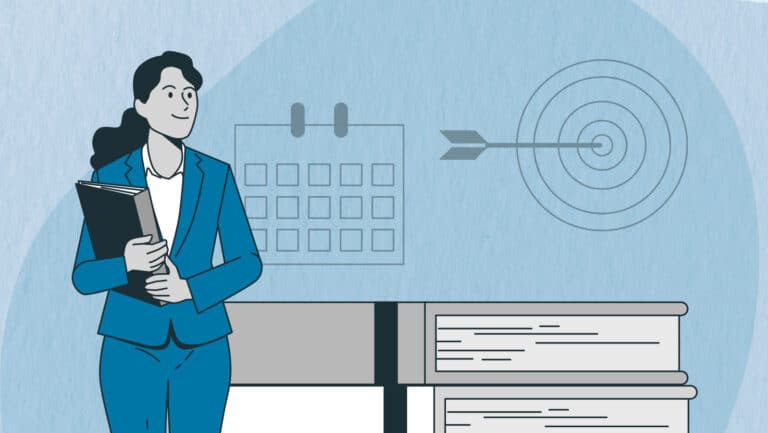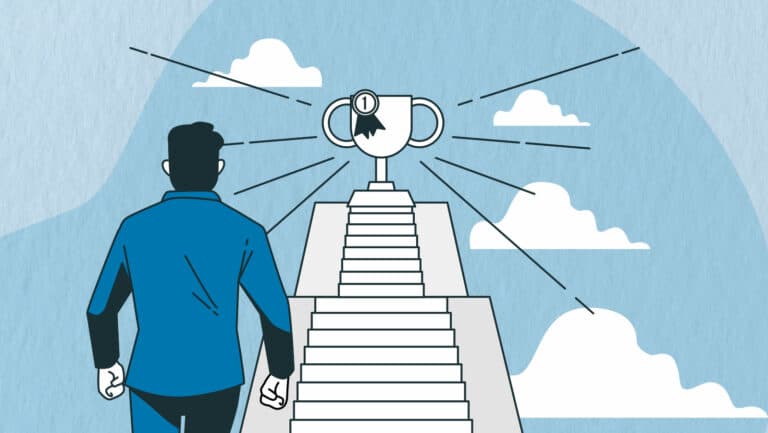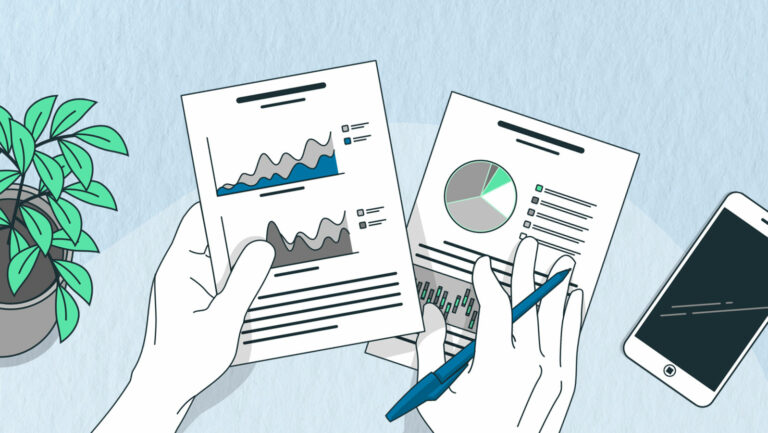RESOURCES ⇢ ORGANIC GROWTH
CRS: The New Customer Engagement Metric To Track Now
Knowing where you stand with customers can be challenging. Especially when other aspects of your customer engagements are at play beneath the surface.
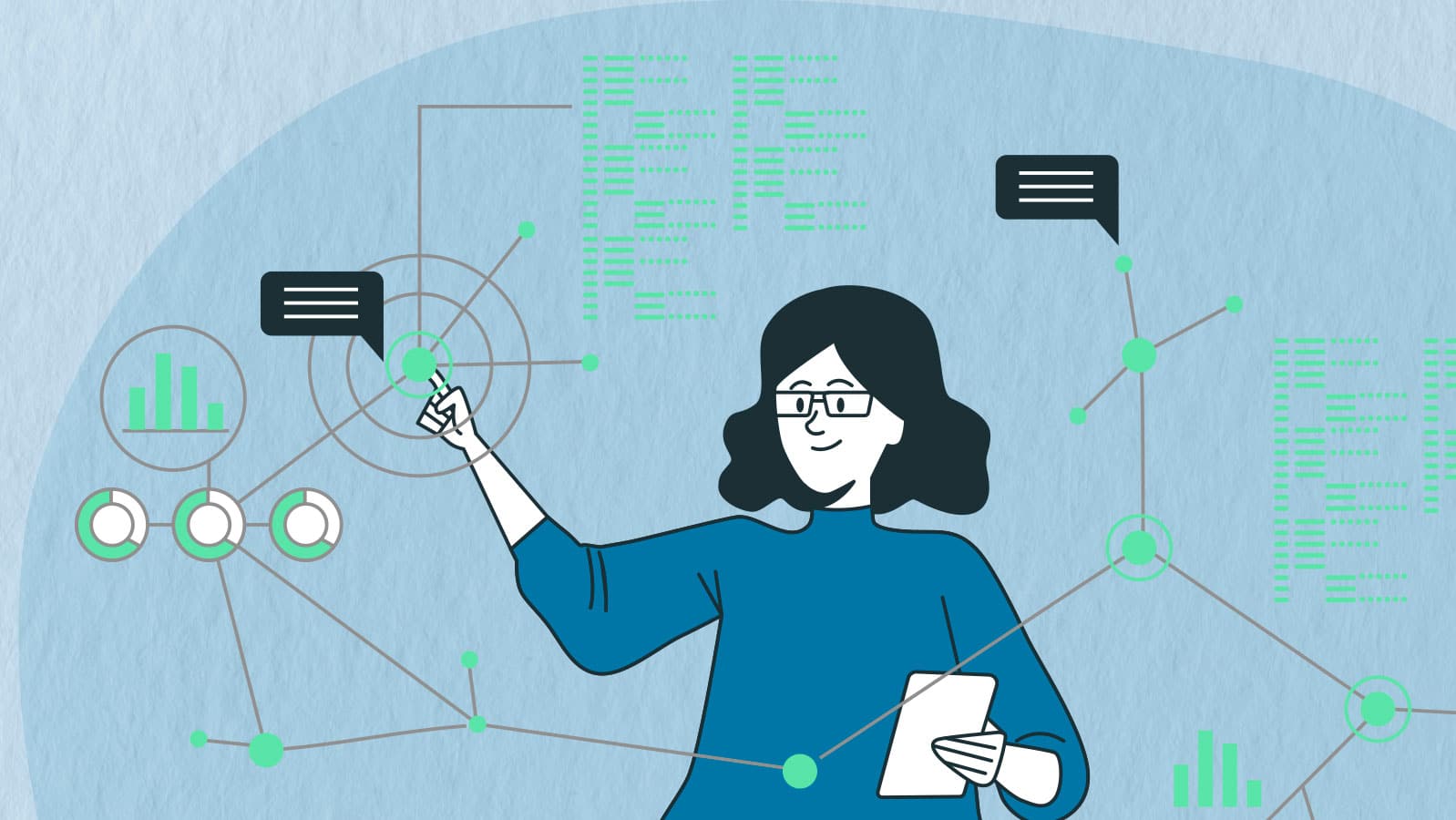
Your multi-year contract is up for renewal, and you believe your competitors would love to be your position. Your team assures you the customer loves your solution, and your NPS and CSAT are glowing and your CES trends low—all painting a picture of success.
You’re relaxed as you login to the call and turn on your camera.
But the award is announced…and it’s not you.
You begin to tense up and a range of emotions hit you as the meeting wraps up.
What went wrong?
You have a relationship blind spot. It’s time to track your Customer Relationship Score (CRS).
WHY ENGAGEMENT METRICS ARE FAILING YOU
Leaders rely on customer engagement metrics like Net Promoter Score (NPS), Customer Satisfaction Score (CSAT), and Customer Effort Score (CES) to gauge relationship health, but these tools often fall short.
Designed for transactional moments, like a satisfaction survey after an engagement, these tools leave a critical gap for B2B and B2G organizations. Studies now show customer satisfaction data does not predict loyalty or accurately describe the nature of a relationship, which is why many are starting to abandon these measurements altogether.
Leaders have recognized these measurements fail to capture the trust, alignment, and emotional connection in complex partnerships, leaving them with an incomplete picture and a lack of actionable insights.

Even when combined into customer health scores, they provide a fragmented view, missing the depth needed for complex sales cycles with high-stakes decisions.
That’s where Customer Relationship Score (CRS) comes in.
insight:
Customer engagement metrics often combined to paint a picture of customer relationship health, but these metrics are not designed to describe the quality of the customer relationship. Other engagement metrics offer fragmented and shallow insights for organizations with complex sales cycles and higher perceived risks.
WHY RELATIONSHIPS ARE YOUR BLIND SPOT
Losing any contract can be incredibly frustrating, especially if you were convinced you would win. And unfortunately, it can have devastating consequences.
When this happens, leaders immediately wonder:
“How could my team let a competitor steal it right from under our noses, and why are our customer metrics not lining up with our reality?! “
The answer is simple: your team overestimated their relationships and your engagement metrics have weak correlations to key outcomes.
In fact, customer relationships are still one of the biggest blindspots for most B2B leaders.
Most teams have no idea how customers actually see them.
We receive calls daily from frustrated leaders who were led to believe they were in great standing with key customers and stakeholders before a significant loss.
Reality rarely matches this self-assessment, as we all naturally overestimate our social abilities and most teams don’t know what makes a customer relationship “great” or what drives loyalty.
If you’re not tracking any KPI associated with customer relationship quality, there is no way for you to validate their claims or understand what’s at risk.

This is the perfect storm clearing a path for your competitors.
We recently met with a CRO who discovered he recently lost a significant contract because the competitor’s team had dug deeper, catching shifts in needs and priorities his program manager, engineer, and even sales team had missed.
While this CRO’s team approached their customer engagements like a checklist, his competitors were hard at work gathering the customer’s real requirements and motives. This mistake cost his organization over $72M in their forecast.
If his team had been measuring and monitoring their customer relationship quality with Customer Relationship Scores (CRS), he would have known this account was at risk.
THIS DISCONNECT IS VERY COSTLY
Many companies pour significant resources into building close relationships with profitable customers, yet their efforts frequently fall short.
The root cause? A lack of clear objectives and measurable progress indicators.
In fact, we’ve found most organizations struggle to define what a strong customer relationship looks like, how to cultivate it, or even how to quantify its impact.
This knowledge gap undermines the effectiveness of CRM and CX initiatives, leading to disappointing returns on investment.
To bridge this divide, a strategic, integrated approach to customer relationship management is essential, with Customer Relationship Score as the guiding light.
CEOs who prioritize customer-centricity are 60% more likely to outperform their competition. (Deloitte)
WHAT IS CRS, AND HOW CAN IT HELP?
At its core, the Customer Relationship Score (CRS) reflects the strength of the partnership: how much customers see your team as a vital ally focused on their success, and not just another vendor.
❌ It doesn’t measure how often your team shares in casual conversations.
✅ It’s a deeper, more strategic measure of how much the customer values your partnership.
Customer Relationship Score (CRS)
A measurement of trust, emotional connection, and strategic alignment between a company and its customers.
Unlike traditional metrics that focus on transactional satisfaction, CRS provides a deeper view of relationship quality and practical steps to take to improve factors driving loyalty, retention, and long-term growth.

By integrating CRS into your workflows, you can align teams, enhance customer loyalty, and fuel sustainable growth.
Innovative firms use Customer Relationship Scores to:
- Assess Relationship Health Quickly
- Segment Accounts by Relationship Strength
- Prioritize Renewal Strategies
- Trigger Proactive Engagement:
- Identify Growth Opportunities
- Monitor Stakeholder Alignment
- Enhance Customer Experience Consistency
- Foster a Customer-Centric Culture
HOW CRS IS CALCULATED
CRS is calculated using the Hi-Q Group CRS Assessment answered by customer-facing roles. This score can be used independently or blended in custom CRS composite scores tailored to an organization’s specific metrics and priorities.
CRS can be used to strengthen a single customer relationship or assess the health of multiple accounts to identify risks and growth opportunities across your portfolio. In B2B and B2G companies, where one relationship doesn’t determine success, CRS provides the insights to manage both the details and the big picture.
This is why the best-performing companies focus on CRS as a leading indicator driving CRM and CX strategies—and it works.
The HI-Q Group CRS Assessment stands out in 3 ways:
1. OBJECTIVE, BEHAVIOR-FOCUSED
The CRS Assessment includes questions like “How often do you discuss the customer’s strategic goals?” or “Do you have access to key decision-makers?”
These questions focus on observable behaviors (e.g., frequency of strategic discussions) and access (e.g., stakeholder engagement), rather than subjective assessments such as, “I think they really love us!”
This contrasts with traditional metrics, which often rely on customer-reported data, such as “How likely are you to recommend us?” (NPS) or “How satisfied are you?” (CSAT).
Organizations are 80% more likely to win if their teams excel at customer engagement¹ and strong engagement strategies can increase their annual revenue by up to 23%².
¹ Deltek Federal Procurement Success | ² Aberdeen Group
By grounding the assessment in employee actions and results, CRS ensures a clear, unbiased view of relationship health, forcing frontline teams to confront gaps they typically overlook.
2. EASE AND SPEED OF EXECUTION
Unlike many engagement metrics, which depend on time-consuming customer input strategies, the CRS Assessment’s limited question set is answered by customer-facing teams, minimizing survey fatigue and ensuring consistent and timely data.
Its flexibility supports monthly check-ins or quarterly reviews, offering deeper insights and clear, actionable steps to take to enhance retention and win rates.
3. TIMELY, ACTIONABLE INSIGHTS
The CRS Assessment’s design allows for ongoing or targeted application, enabling real-time insights into individual customer relationships or account-wide health.
For example, a low account CRS might reveal a lack of stakeholder access, prompting immediate actions such as scheduling a strategic meeting for increased penetration. Or an individual low CRS could signal to leadership a coaching opportunity for customer-facing roles on the account.
These insights into key customer relationships and accounts are critical to protect your business.

Businesses need to constantly evaluate how they do business with people. [This training] will create a team enabled to build deep embedded partnerships that provide the business long term, sustainable and desirable results across the organization.
CRS fosters team accountability, clarifying relationship strengths and prompting proactive action. Integrated into CRM dashboards, individual or account-wide scores provide a clear view of risks and opportunities across target accounts.
WHAT FACTORS AFFECT CRS SCORES?
The following elements affect your team’s individual Customer Relationship Score:
-
Customer Engagement Skills: The ability to connect meaningfully with customers.
-
Frequency & Depth of Engagements: How often and how deeply employees engage with customers.
-
Customer Understanding: Knowing what matters to the customer and aligning efforts to match.
-
Customer Expectations Management: Setting and meeting realistic expectations.
-
Customer Interaction Outcomes: The results of employee-customer exchanges.
-
Level of Customer-Centricity: Putting the customer’s needs first.
-
Organizational & Situational Awareness: Understanding the customer’s broader context.
-
Collaboration & Adaptability: Working together on solutions and adapting to changing needs.
CRS uncovers critical blind spots by revealing the disconnect between employees’ perceived relationship-building practices and their actual effectiveness.
Customer-centric companies are 60% more profitable than other firms.
DELOITTE & TOUCHE
WHY MEASURING CRS IS CRITICAL
Businesses claim they prioritize customer experience, with 90% saying it’s their primary focus (CX Index) and even 44.5% believe their customer experience is their primary competitive differentiator (Statista).
Yet time and time again, we speak with well-meaning, sophisticated companies who don’t have the slightest idea where they stand with customers.
That’s why its unsurprising for us to see:
- Overall customer satisfaction continuing to decline (ASCI)
- Customer experience quality falling to an all-time low (Forrester)
- B2B organizations consistently rated lower in experience compared to B2C (McKinsey)
- B2B churn continue to increase by 15% over the last 5 years (Gartner)
Your customers expect more from your team now more than ever.
In fact, at least 80% of B2B customers expect their experience to match or exceed the standards of B2C. (?) And while a whopping 80% of businesses believe they provide superior customer experiences, only 8% of customers agree (Bain & Company).
That’s a significant gap.
If you’re tired of missed targets and unpleasant surprises, it’s time to start measuring CRS and truly understand where you stand with your customers.
Remember the wise words of Peter Drucker:
“If you can’t measure it, you can’t improve it.”
MEASURE WHAT MATTERS
CRS is a critical part of your customer experience strategy.
Customer Relationship Score (CRS) is a differentiator and growth accelerator. But it’s also a missing customer engagement metric on most dashboards.
Ask yourself:
- Does your team understand your customers’ priorities and emerging needs?
- Does your frontline team know what a “great” relationship looks like, and have they been trained in customer relationship skills?
- Does your CRM or CX initiatives fail to deliver your desired ROI?
Stop guessing and start winning.
Add CRS to your dashboard. Define it. Measure it. Act on it. When you know your customer better than anyone else, you don’t just compete—you win.
TAKE ACTION:
You’ve seen the symptoms of poor customer engagement and the missed opportunities. Now, it’s time to get serious about transforming how your organization approaches customer relationships.
Schedule a confidential 30-minute consultation with our growth specialist to explore how adopting CRS could dramatically shift your results.
learn more:
FREQUENTLY ASKED QUESTIONS
WHY ARE CUSTOMER ENGAGEMENT METRICS IMPORTANT?
Customer engagement metrics are critical metrics for B2B organizations because they reveal how clients interact with your brand across customer touchpoints, guiding customer engagement strategies to foster customer loyalty, reduce customer churn rate, and drive business growth. In B2B, where relationships span multiple stakeholders and long sales cycles, these metrics help business owners understand customer behavior, satisfaction levels, and commitment over a time frame. For instance, common metrics like Net Promoter Score (NPS) gauge advocacy, while Customer Satisfaction Score (CSAT) measures strong customer satisfaction at specific interactions, such as support calls.
However, traditional metrics often focus on transactional moments, missing the trust and strategic alignment vital for lasting partnerships. Customer Relationship Score (CRS), an essential metric, addresses this gap by assessing relationship depth through employee-driven assessments. CRS provides valuable insights into customer sentiment and engagement levels, enabling leaders to prioritize high-value customers and mitigate risks like poor customer experiences. By tracking these key indicators, B2B teams can align around a customer experience strategy, ensuring customer retention, happy customers, and long-term business success. Unlike vanity metrics that offer surface-level data, CRS drives stronger customer relationships, making it a source of innovation for sustainable growth.
WHAT ARE THE CUSTOMER ENGAGEMENT METRICS THAT MATTER TODAY?
Today’s B2B leaders rely on a mix of essential customer engagement metrics to track strong customer engagement effectively, ensuring they meet the needs of diverse customer segments:
- Net Promoter Score (NPS): Measures the likelihood of customers recommending your business, reflecting customer loyalty and advocacy.
- Customer Satisfaction Score (CSAT): Assesses satisfied customers with specific interactions, like support or sales processes, over a time frame.
- Customer Effort Score (CES): Evaluates the ease of doing business, focusing on reducing friction in customer interactions to enhance satisfaction levels.
- Customer Relationship Score (CRS): A fundamental metric that measures trust, emotional connection, and strategic alignment, offering deeper engagement insights into B2B partnership quality.
While NPS, CSAT, and CES are common metrics providing valuable snapshots, they often lack the depth needed for B2B’s complex dynamics. For example, NPS may not capture the full customer lifecycle, and CES focuses narrowly on ease. Hi-Q Group’s CRS complements these by focusing on relationship strength, helping leaders segment customers and prioritize high-value customers for customer retention and expansion. By integrating these customer engagement KPIs into a strategic approach, businesses can foster stronger customer relationships, reduce customer churn rate, and drive business performance. This streamlined approach ensures engaged customers contribute to a robust customer base, supporting long-term business success.
WHAT IS A CUSTOMER ENGAGEMENT METRIC EXAMPLE?
A prime example of a customer engagement metric is the Customer Relationship Score (CRS), which quantifies trust, emotional connection, and strategic alignment in B2B relationships. Unlike transactional metrics like CSAT, which measures strong customer satisfaction after a single interaction, CRS uses employee-driven assessments to provide engagement insights in real time. For instance, a sales team might use CRS to identify an account with low trust, prompting targeted outreach to strengthen the relationship before a renewal. This focus on customer actions and customer behavior makes CRS a crucial metric for B2B leaders navigating complex sales cycles. By offering valuable insights into deeper engagement, CRS ensures businesses prioritize high-value customers and address risks, fostering stronger customer relationships and avoiding poor customer experiences.
Another example is the customer engagement score, which tracks engagement levels across customer touchpoints, such as website visits or support interactions. While a customer engagement score provides broad data, it may act as a vanity metric without the depth of CRS, which ties engagement to business health and customer lifetime value. Together, these metrics help business owners make data-driven decisions for successful customer engagement.
WHAT IS AN ENGAGEMENT METRIC?
An engagement metric quantifies how actively and meaningfully customers interact with a company, reflecting their customer loyalty, satisfaction levels, and commitment across the customer lifecycle. In B2B, these metrics are essential metrics for understanding partnership dynamics across multiple stakeholders. For example:
- Net Promoter Score (NPS): Measures advocacy, showing how likely customers are to recommend your business.
- Customer Effort Score (CES): Assesses ease of customer interactions, ensuring a frictionless experience.
- Customer Satisfaction Score (CSAT): Gauges happy customers at specific customer touchpoints.
- Customer Relationship Score (CRS): Evaluates relationship quality through trust and alignment, offering engagement insights for B2B partnerships.
Each metric provides a piece of the engagement puzzle, with CRS standing out as a critical metric for capturing nuanced, relationship-driven aspects. By analyzing customer actions and customer sentiment, CRS guides customer engagement strategies to build a loyal customer base, reduce customer churn rate, and drive business growth. Unlike vanity metrics, CRS ensures strong customer engagement by focusing on stronger customer relationships.
IS CUSTOMER ENGAGEMENT A KPI?
Yes, customer engagement is a Key Performance Indicator (KPI) in B2B organizations, as it directly influences customer retention, retention rates, customer lifetime value, and business growth. Metrics like the Customer Relationship Score (CRS), which measures trust and strategic alignment, serve as customer engagement KPIs by linking engagement to tangible results like account expansion or reduced customer churn rate. For example, a high CRS score indicates a strong partnership ready for sales opportunities, while a low score signals a need for intervention to avoid poor customer experiences. Another customer engagement score might track customer actions across customer touchpoints, providing broader data but less depth than CRS.
By integrating these key metrics into a customer experience strategy, B2B leaders can align sales teams and customer success teams around customer-centric goals, ensuring strong customer satisfaction and business performance. This fundamental metric supports business health by fostering happy customers and a loyal customer base, driving long-term business success through stronger customer relationships.
HOW CAN BUSINESSES USE CUSTOMER ENGAGEMENT METRICS TO grow?
Businesses can drive business growth by leveraging customer engagement metrics to inform customer engagement strategies and a customer experience strategy. By tracking key metrics like customer retention, customer lifetime value, and customer churn rate, businesses can identify areas for improvement and focus on retaining loyal customers while attracting new ones. For instance, understanding customer segments and using a streamlined approach to segment customers based on engagement levels allows businesses to tailor their approaches, ensuring high-value customers receive personalized attention to maintain stronger customer relationships.
Metrics like Net Promoter Score (NPS), Customer Effort Score (CES), and Customer Satisfaction Score (CSAT) provide valuable insights into customer sentiment and satisfaction levels, enabling data-driven decisions that enhance the customer experience. For example, survey responses from CSAT can reveal friction points, while CES ensures customer interactions are seamless. The Customer Relationship Score (CRS) offers deeper engagement insights, helping businesses build a customer base that is not only satisfied customers but also engaged customers. This strategic approach avoids vanity metrics, focusing on essential customer engagement metrics that drive business performance. By acting as a source of innovation, CRS and other metrics ensure successful customer engagement, fostering long-term business success and a competitive edge.
